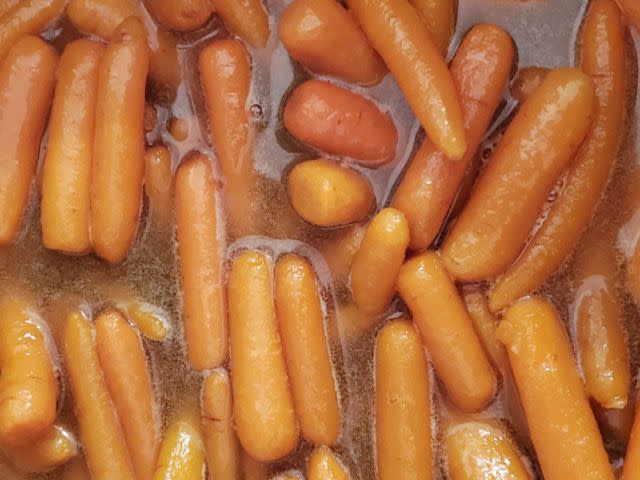This Is the Reason Your Baby Carrots Are Always Wet
Plus, how to store them so they stay fresh and slime-free for longer.

Allrecipes/Getty Images
Baby carrots are, by all accounts, a curious produce item. They’re so polished, so smooth, so rounded, and just…so uniform. Of course, it’s not uniformity that’s earned the baby carrot a revered spot in crisper drawers across the country (mine included)—it’s convenience.
Baby carrots require no washing or peeling, simply open the package and they’re ready to go. Use them for dipping, for roasting, for whatever you please! They’re here to offer a type of luxurious ease we all deserve a taste of. Still, there is one feature of these conveniently bite-sized hummus vehicles that has always given me pause: the amount of liquid present in every bag. I mean, why are they so wet?
As it turns out, the liquid is there for a reason and no cause for concern.
Where Do Baby Carrots Come From?
Before we address why baby carrots are often wet with moisture when pulled from the bag, it’s important to understand their basic anatomy—in other words, what is a baby carrot?
Baby carrots, also labeled as “baby-cut” carrots, are not plucked from the ground as the pristine batons you find packaged in the supermarket’s produce section. They are made from fully-grown carrots that have snapped into pieces during the harvesting process or are too irregular in shape or size to sell as-is. To avoid waste, these “ugly” adult carrots are peeled, trimmed, and shaped into roughly two-inch-long minis by machine. The baby carrots are then washed with a chlorine solution (as many fresh-cut vegetables are) and thoroughly rinsed before packaging.

Brie Goldman/Allrecipes
Why Is There So Much Moisture in Packages of Baby Carrots?
The reason baby carrots often emerge from their packaging wet is, they’re bagged with added water. Unlike the whole carrots they’re carved from, baby carrots do not have a natural outer peel. Although this is one of the features that makes baby carrots incredibly convenient, a carrot’s natural peel helps the vegetable retain moisture so that it stays crisp, rather than becoming prematurely limp and rubbery. In order to combat dehydration, food manufacturers add filtered tap water to the bag of freshly cleaned baby carrots before sealing. This added water helps to ward off the unsightly (but totally safe) white “blush” that baby carrots are prone to develop as they begin drying out.
So, while there’s nothing inherently off or icky about the moisture in your bag of baby carrots, sitting in a pool of the same carrot water for an extended amount of time can expedite the carrots’ developing a slimy exterior. Unlike blush, this sliminess is a strong indicator that your carrots have gone bad and should be tossed or composted.

DOTDASH MEREDITH FOOD STUDIOS
How to Prevent Baby Carrots From Becoming Slimy
Left in the original package, your baby carrots should hold up fine for at least one week; however, you can easily extend the lifespan of your baby carrots with thoughtful storage.
Because there’s no sure way of knowing just how long your baby carrots have been sitting in the water they were originally packaged with, I would always suggest transferring the carrots to a fresh zip-top bag or lidded container once you bring them home. You don’t necessarily need to rinse the carrots, but do discard the remaining liquid in the original package when you transfer them.
If you tend to go through packages of baby carrots quickly (i.e. within a week), no need to add water to the new bag or container before refrigerating. (Note: If white blush happens to develop during this time, simply add cold water to the container to cover; the blush will disappear.) However, if you foresee them hanging around for longer, add enough clean, cold water to cover the carrots. To prevent bacterial growth, change the water every 4-5 days.
How to Use Baby Carrots
Although they’re obviously ideal for piling onto veggie trays and snacking on raw, you can reach for baby carrots just about anytime you would use full-sized, whole carrots. For an impressive side dish, baby carrots can be cooked to caramelized perfection in the oven or simmered and glazed on the stovetop. They’re also easily boiled and pureed into a comforting carrot soup.

You can cut baby carrots into smaller pieces to use in salads or other cooked recipes, but remember to be especially cautious when chopping baby carrots, as their small, round shape makes them prone to slipping on the cutting board. To prevent accidental injury, it’s best to cut each baby carrot in half lengthwise and place them flat side down before proceeding to cut into smaller pieces.
Read the original article on All Recipes.


